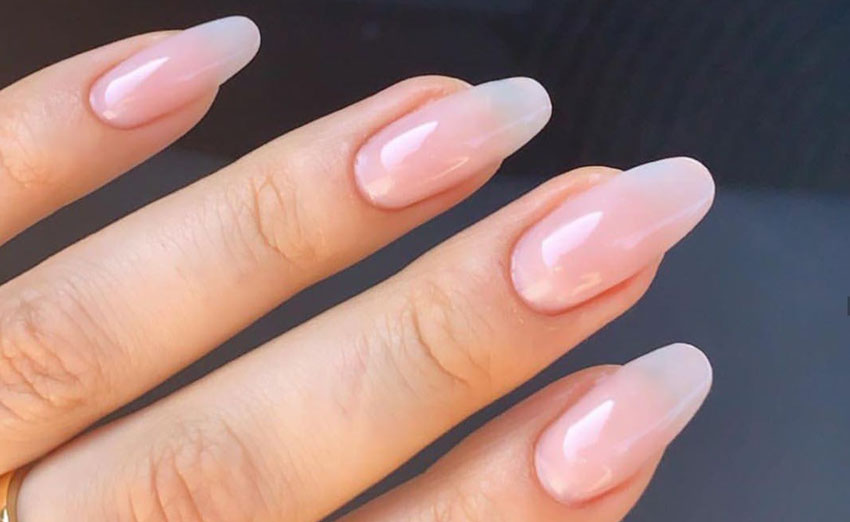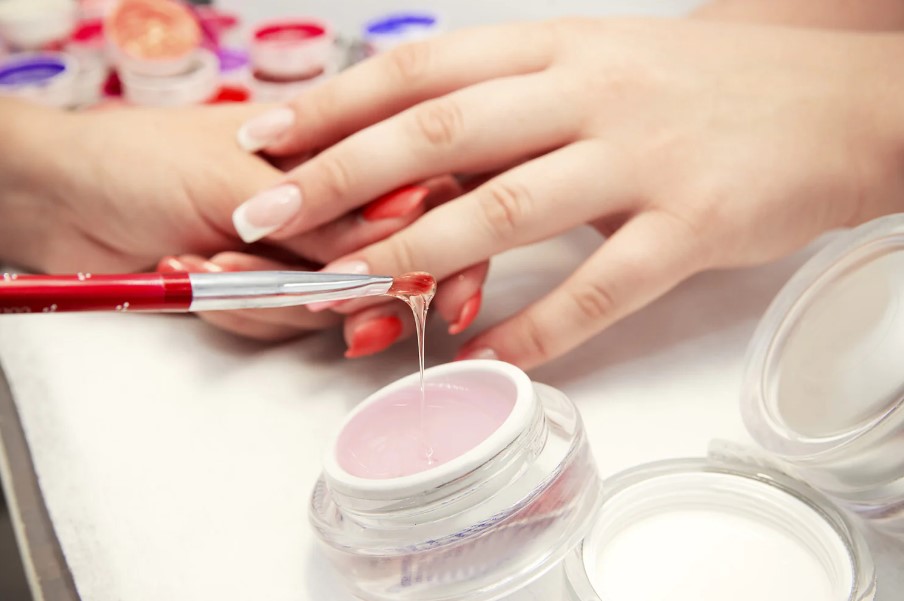Our love for all things nail-related, from staying updated on manicure trends to caring for our natural nails, centers around the common theme of nail length. Specific lengths are often necessary, especially for those who want to know what kind of tips are best for nails. Achieving the desired length can be challenging, especially for those with nail-biting habits or naturally weak nails that are prone to breakage. However, there are options to fake length, such as using press-on nails for a temporary fix or opting for more permanent solutions like gel tips vs. acrylics, which can be customized to suit individual nail shapes.
What are acrylic nails?
Acrylic nails consist of a combination of poly powder and monomer liquid, creating a matte jelly-like substance that serves to both protect and extend your natural nails. This versatile material can be applied as an overlay on existing nails, augmented with plastic tips for desired lengths, and expertly sculpted into various shapes and lengths. In contrast to gel tips, the unique characteristic of acrylics is their longevity, as they are not intended for removal after each nail service. Instead, clients are advised to schedule regular appointments for acrylic fills or rebalancing to maintain the integrity of the application.

What are gel tips on nails for?
Contrary to common misconceptions, these are crafted from plastic rather than gel and are pre-formed into specific shapes. Affixed to the natural nail using a UV-cured gel product, gel tips typically come in clear, full-cover designs with a diverse range of sizes, lengths, shapes, and thicknesses, making them a swift application choice. Unlike some alternatives, gel tips are intentionally designed for removal and replacement. Individuals wearing them are encouraged to seek professional removal to preserve the health of the natural nail and ensure a seamless transition.
What are the differences between tips and acrylics?
Curious about the distinctions between gel nail tips vs. acrylic? If you’re gearing up for your upcoming nail appointment, consider discussing these nuances with your technician to gain insight before your session begins.
The Application Process
Acrylic nails are applied by first filing down your natural nails to create a textured surface for the glue. The acrylic powder and liquid, known as polymer and monomer, are then combined to form a mixture that molds onto your nails. The artificial nail is shaped and buffed to achieve the desired length and shape. Acrylics containing methacrylates, cure upon application due to contact with air. Unlike gel nails cured under UV light, acrylics need to be applied swiftly. The removal involves soaking in acetone for 20 minutes, offering a distinctive difference from gel nails, which are self-reliant and don’t require polymer powders.
Gel nails made their debut in the beauty industry in the 1980s, starting with hard gels and evolving into softer variations such as soft gels and gel polishes. For hard gels, the application involves a bonder, a base coat, a builder for the artificial nail, and a clear top coat for a glossy finish, with curing under a UV lamp. Removal requires filing, as hard gels cannot be soaked off. Soft gels and gel polishes, known for their liquid consistency, are suitable for strengthening shorter, weaker nails. While popular, they can be challenging to soak off during removal and lack the option for a protective base coat before application. Some may also dry out if left open and exposed to air due to their hybrid nature, combining gel polish and regular nail polish.
Potential Side Effects
While obtaining gel nails generally poses no side effects, the potential for damage arises during the removal process if not executed correctly. Therefore, the importance of seeking professional assistance for proper removal is emphasized. Additionally, the only consideration is the duration of removal, which varies based on whether you have soft or hard gel.
Similar to gel tips, potential side effects arise during the removal process of acrylic nails. It’s highlighted that these side effects are generally minimal, except when dealt with by an inexperienced nail technician who neglects the precision of nail care. In such cases, there is a risk of infection if the nails are not filled in correctly.
Durability
Gel nail polish usually maintains its integrity for approximately two weeks before showing signs of wear, such as peeling or lifting at the corners nearing the 14-day mark. While more resilient than regular polish, gel polish isn’t as robust as acrylic since it adheres to your natural nails. The strength of your gel polish is influenced by the condition of your natural nails, and despite its resistance to chipping, the risk of breaking exists, especially if your natural nails are weakened or if you engage in hands-on activities.
On the other hand, acrylic nails can endure for over three weeks and can be refilled multiple times before requiring a completely new set. Their durability minimizes concerns about cracking, breaking, or lifting during wear. However, engaging in activities that involve significant handwork, such as typing, washing dishes, or weightlifting, may pose a risk of breakage, potentially causing damage to your natural nails.
Costs
The cost of gel nail polish application on natural nails typically ranges between $30 and $70, varying based on your location and the salon you choose. For acrylic nails, the expense can fall anywhere between $30 and $100 or more, contingent on factors like your location, the chosen length, and additional services. Combining acrylic with gel nail polish for a robust manicure, which may include faux nail tips or trendy nail art, can result in a total cost ranging from $50 to $100 or more.
Although the initial visit for acrylic nails might be pricier, the advantage lies in the possibility of fills. Acrylic fills target the regrowth at the nail base, with the nail technician replenishing this area with new acrylic, hence the term “fill.” This means you won’t have to pay for an entirely new set every time you maintain your acrylic nails.

Nail tips vs. Acrylic: which one should you get?
Ultimately, the choice between full-cover tips and acrylic nails hinges on individual lifestyle and maintenance preferences. According to experts, the application of full-cover tips is initially a speedy process, allowing for flexibility in changing the shape and length during each appointment, albeit requiring some additional time for removal. On the other hand, acrylic nails offer the advantage of not needing removal at every appointment, eliminating the requirement for a UV light during application, and providing the freedom to wear extreme lengths with enhanced support.

